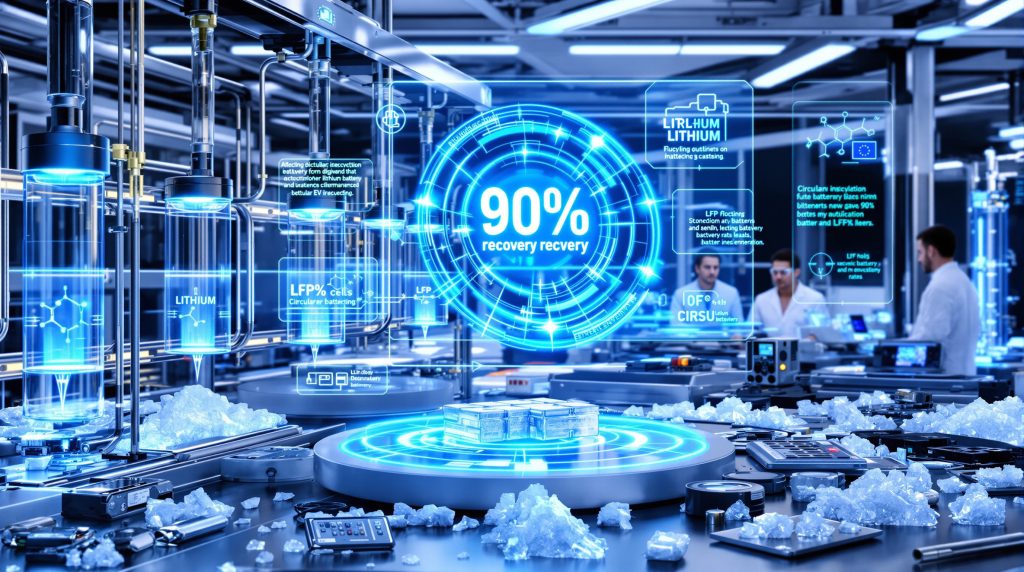What Makes Lithium Recovery from EV Batteries So Important?
The rapid expansion of electric vehicle adoption is creating unprecedented demand for lithium, with global needs projected to increase 40-fold by 2040 according to the International Energy Agency. As millions of EV batteries approach their end-of-life cycle, recovering lithium has evolved from an environmental concern into a strategic economic opportunity that's reshaping the battery supply chain.
With the average electric vehicle battery containing between 5-10 kg of lithium materials, the cumulative value locked in spent batteries represents billions of dollars in recoverable resources. Traditional mining operations alone cannot sustainably meet this surging demand, especially as manufacturing capacity continues to outpace raw material availability.
Environmental considerations further elevate the importance of efficient recovery technologies. Primary lithium extraction requires between 500,000-750,000 liters of water per tonne of lithium produced in traditional evaporative operations, placing immense pressure on water resources in already vulnerable regions.
The recycling imperative extends beyond environmental considerations to supply chain resilience. Recent geopolitical tensions have highlighted vulnerabilities in critical mineral supply chains, with over 90% of global lithium processing currently concentrated in China. Advanced recovery technologies represent a pathway to greater resource security for Western economies investing heavily in electric transportation.
The Scale of the Challenge
Industry forecasts suggest that by 2030, over 12 million tonnes of EV batteries will reach end-of-life status globally. Without effective recycling pathways, this represents both a waste management crisis and a missed opportunity to recapture valuable materials that could support manufacturing tens of millions of new vehicles.
Battery manufacturers and automakers are increasingly viewing recycling not merely as a sustainability initiative but as a fundamental component of their business models. Companies like Tesla have developed in-house recycling capabilities specifically designed to recover lithium and other critical minerals from their own battery systems.
How Do Traditional Lithium Recovery Methods Work?
Conventional Pyrometallurgical Processes
Pyrometallurgical recycling represents the first generation of battery recycling technology, employing high-temperature smelting that typically operates between 1,400-1,500°C. This process effectively recovers cobalt, nickel, and copper but comes with significant drawbacks for lithium recovery.
The extreme temperatures create a metal alloy containing valuable cobalt and nickel, while lithium typically migrates to the slag waste. This inefficient transfer results in lithium recovery rates of merely 5-10%, essentially wasting this increasingly valuable resource.
The energy intensity of pyrometallurgical processes presents another significant concern. These operations typically consume 5,000-8,000 kWh per tonne of processed material, contributing substantially to the carbon footprint of what should be a sustainability-focused operation.
Emissions management adds further complexity, as the high voltage battery recycling of organic battery components generates potentially hazardous compounds that require sophisticated abatement systems to prevent environmental contamination.
Standard Hydrometallurgical Approaches
Conventional hydrometallurgical methods represent an evolution in battery recycling technology, using chemical leaching rather than extreme heat to extract metals from battery materials. These processes typically employ acid or base solutions to selectively dissolve target metals into solution.
The process generally involves mechanical preprocessing (crushing and grinding), followed by leaching with agents such as sulfuric acid, hydrochloric acid, or nitric acid. Subsequent separation stages use precipitation, solvent extraction, and ion exchange to isolate individual metals.
While more effective than pyrometallurgy for lithium recovery, standard hydrometallurgical methods still achieve only 30-50% lithium recovery rates. This limitation stems from inefficient leaching kinetics and solution management challenges that allow significant lithium losses throughout the multi-stage process.
Chemical consumption represents another drawback, with typical operations using 2-3 tonnes of reagents per tonne of battery material processed. This creates substantial waste management challenges and increases operational costs, particularly as reagent prices fluctuate with broader chemical market dynamics.
The wastewater generated requires extensive treatment before release, adding another layer of operational complexity and cost that has limited widespread commercial adoption despite the theoretical advantages over pyrometallurgical approaches.
What Breakthrough Technologies Are Transforming Lithium Recovery?
University of Wisconsin-Madison's Electrochemical Innovation
A research team led by Professor Kyoung-Shin Choi at the University of Wisconsin-Madison has developed a groundbreaking electrochemical technology specifically targeting lithium-iron-phosphate (LFP) batteries. This innovative approach operates at room temperature and demonstrates significantly higher lithium recovery rates than conventional methods.
The two-stage process begins with a controlled chemical pretreatment using minimal reagents, followed by an electrochemical separation that selectively extracts lithium ions without degrading other materials. This selectivity represents a fundamental advancement over traditional methods that struggle with LFP chemistry.
The technology has demonstrated success with both commercial batteries and recycling "black mass" – the mixed material output from battery shredding operations. This versatility positions the technology for integration into existing recycling infrastructure rather than requiring entirely new processing facilities.
Perhaps most importantly, the process operates at ambient temperature with significantly lower energy requirements than conventional alternatives. This reduces both operational costs and environmental impact while improving recovery economics.
The researchers have formed a startup venture to scale and commercialize the technology, with initial pilot testing scheduled to begin within the next 24 months. Several major battery manufacturers have expressed interest in the battery recycling breakthrough as they seek to comply with upcoming recycled content requirements.
Microbial Electrochemical Technology (BES)
Scientists at the University of Surrey have pioneered a bioelectrochemical system that leverages microbial activity to recover lithium from spent batteries. This novel approach combines biological processes with electrochemistry to achieve remarkable efficiency improvements over traditional methods.
The BES technology utilizes specialized microorganisms that can catalyze electrochemical reactions at significantly lower energy levels than conventional chemical approaches. This biological assistance enables the system to operate with minimal external energy input while maintaining high recovery rates.
Performance metrics for the BES technology demonstrate its potential:
| Feature | Performance |
|---|---|
| Recovery Rate | 90-95% |
| Output Purity | Battery-grade |
| Environmental Impact | Minimal chemical usage |
| Energy Requirements | 60-80% lower than conventional methods |
| Applicability | Works across multiple battery chemistries |
The system's versatility across battery chemistries represents a significant advantage as manufacturers continue to evolve their formulations. Where conventional methods often require reconfiguration for different battery types, the BES approach maintains effectiveness across a spectrum of lithium-containing batteries.
The technology also produces fewer secondary waste streams than chemical-intensive approaches, reducing the overall environmental footprint of the recycling operation. This aligns with increasingly stringent regulatory requirements for waste management in recycling operations.
Advanced Solvent Extraction Processes
A collaboration between recycling firm cylib and chemical company Syensqo has yielded impressive results using proprietary solvent extraction technology specifically designed for battery material recovery. Their approach focuses on producing battery-grade lithium hydroxide directly from spent EV batteries.
The process employs CYANEX® 936P extractant, which demonstrates enhanced selectivity for lithium ions even in complex solutions containing multiple metallic elements. This selectivity reduces the number of purification steps required to achieve battery-grade output.
A key innovation in their approach is the ability to process multiple battery chemistries on a single production line. This flexibility eliminates the need for segregation by chemistry type, which has been a significant operational challenge for many recycling facilities.
The output quality meets or exceeds the stringent purity requirements for battery manufacturing, allowing direct reintegration into the battery production supply chain without intermediate processing. This closed-loop capability improves overall system economics while reducing transportation and handling requirements.
The technology has progressed beyond laboratory testing to pilot-scale operations, with commercial implementation scheduled within the next 18-24 months. Initial economic assessments suggest the process could achieve production costs competitive with primary lithium sources at scale.
Why Are LFP Batteries Particularly Challenging to Recycle?
Lithium iron phosphate (LFP) batteries present unique recycling challenges that have accelerated innovation in recovery technologies. These batteries have gained significant market share in the EV sector, with manufacturers like Tesla and BYD increasingly adopting them for their cost advantages and improved safety profiles.
The fundamental recycling challenge with LFP batteries stems from their material composition. Unlike nickel-manganese-cobalt (NMC) chemistries that contain valuable metals like cobalt ($30,000-50,000/tonne) and nickel ($15,000-25,000/tonne), LFP batteries contain primarily iron and phosphate—materials with minimal recycling value (less than $500/tonne).
This composition creates challenging economics for traditional recycling operations. When lithium is the only economically significant recoverable component, representing 5-7% of the battery mass, conventional recycling methods struggle to generate viable returns. Pyrometallurgical processes are particularly ill-suited, as they typically lose most lithium to slag waste.
The material properties of LFP compounds further complicate recovery efforts. The strong chemical bonds between lithium, iron, and phosphate make the material highly stable—a beneficial safety feature during use but a significant challenge during recycling. These bonds require more aggressive leaching conditions than other battery types, increasing process complexity and cost.
Despite these challenges, LFP batteries continue gaining market share due to their lower production costs (approximately 30% less than NMC alternatives) and reduced supply chain risks from avoiding cobalt and nickel. This growing market presence has intensified the need for LFP-specific recycling solutions that can economically recover lithium despite the absence of other valuable metals.
How Will Regulatory Changes Impact Lithium Recovery?
European Union Battery Regulations
The EU has established the world's most comprehensive regulatory framework for battery recycling through Regulation 2023/1542, which entered into force in August 2023. This landmark legislation will fundamentally reshape recycling economics and drive technology adoption across the industry.
Starting in 2031, all new batteries sold in the EU must contain minimum percentages of recycled content: 6% for lithium, 16% for cobalt, and 6% for nickel by weight. These thresholds increase further in subsequent years, creating guaranteed market demand for recycled materials that will drive investment in advanced recovery technologies.
The regulation also establishes mandatory collection targets for end-of-life batteries, ensuring that recyclers have sufficient feedstock to achieve economies of scale. These targets include:
- 45% collection rate by 2023
- 65% collection rate by 2025
- 70% collection rate by 2030
Extended producer responsibility provisions place the recycling burden directly on manufacturers, who must ensure their products meet end-of-life management requirements. This creates financial incentives for automakers to invest in recycling partnerships and technologies that can efficiently recover their specific battery materials.
The legislation also mandates standardized labeling and documentation of recycled content, creating transparency throughout the supply chain. This will allow consumers and regulators to verify compliance while encouraging market competition based on circular economy performance.
North American Policy Development
While less comprehensive than the EU framework, North American regulations are evolving rapidly. The U.S. Inflation Reduction Act includes provisions that incentivize domestic battery production and recycling through tax credits and grants, with $335 million specifically allocated for battery material recycling programs.
The U.S. Department of Energy's ReCell Center represents a coordinated research effort to develop cost-effective recycling technologies, with particular focus on direct lithium extraction methods that could preserve the higher-value crystalline structure of battery materials rather than breaking them down to elemental forms.
Canada's Critical Minerals Strategy similarly emphasizes battery recycling as a key component of supply chain security, with federal and provincial funding supporting technology development and implementation. The proximity of manufacturing facilities in Ontario to emerging U.S. battery production creates potential for integrated recycling networks.
What Economic Factors Drive Lithium Recovery Innovation?
Market Dynamics and Supply Chain Resilience
The economic case for lithium recovery has strengthened dramatically as market conditions evolve. Primary lithium prices have demonstrated significant volatility, ranging from $7,000 to over $80,000 per tonne between 2020 and 2023. This price uncertainty creates financial risk for battery manufacturers and automakers with long-term production commitments.
Supply chain vulnerabilities have become increasingly apparent, with geopolitical tensions affecting traditional lithium mining regions. China's dominance in processing (controlling over 60% of global lithium refining capacity) has prompted Western economies to seek alternative sources, with recycling representing a domestically controllable supply stream.
Production bottlenecks continue to impact market stability. Recent operational challenges in Chinese production facilities and technical issues in Chilean extraction operations have highlighted the fragility of the global supply network. These disruptions ripple through the supply chain, affecting battery production schedules and ultimately vehicle delivery timelines.
Investor interest in battery metals investment has accelerated in response to these conditions. Companies developing advanced recycling technologies have secured over $3 billion in funding since 2020, with particular emphasis on processes that can achieve battery-grade output quality without excessive energy or chemical inputs.
Manufacturing independence has become a strategic priority for many automakers. Companies like Volkswagen, GM, and Ford have established direct partnerships with recycling technology developers to secure priority access to recovered materials, viewing this as essential to their long-term competitive positioning in the EV market.
Economic Competitiveness of Recycling vs. Mining
The economic comparison between recycled and virgin lithium continues to evolve with technology improvements. Current advanced recovery methods can produce battery-grade lithium at approximately $10,000-15,000 per tonne, approaching cost parity with traditional mining operations in many market conditions.
This cost structure improves further when considering the holistic economics of integrated recycling operations that recover multiple materials simultaneously. When combined with cobalt and nickel recovery from NMC batteries, the overall system economics become increasingly favorable, with some operations projecting profitability even at lower lithium price points.
The capital intensity of recycling facilities presents a significant advantage over new mining operations. A world-scale lithium recycling facility with 50,000 tonnes annual capacity typically requires $100-150 million in capital investment, compared to $500-800 million for a comparable primary extraction operation, with substantially faster time-to-market.
Location economics further advantage recycling operations, which can be situated near battery manufacturing facilities to minimize transportation costs and supply chain complexity. This proximity creates logistical advantages while reducing the carbon footprint associated with material movement through the supply chain.
How Do These Technologies Compare in Performance?
The performance characteristics of different lithium recovery technologies vary significantly across key operational parameters. This comparison highlights the evolutionary improvements achieved through recent innovations:
| Technology | Recovery Rate | Energy Requirements | Chemical Usage | Scalability | Economic Viability |
|---|---|---|---|---|---|
| Pyrometallurgical | 5-10% | Very High (5,000-8,000 kWh/t) | Moderate | High | Low for lithium |
| Conventional Hydrometallurgical | 30-50% | Moderate (1,000-2,000 kWh/t) | High (2-3t reagents/t battery) | Moderate | Moderate |
| Wisconsin-Madison Electrochemical | 70-80%* | Low (300-500 kWh/t) | Low (0.5-1t reagents/t battery) | Developing | High potential |
| Microbial Electrochemical (BES) | 90-95% | Very Low (200-300 kWh/t) | Minimal (< 0.5t reagents/t battery) | Developing | High potential |
| Advanced Solvent Extraction | 80-90%* | Moderate (800-1,200 kWh/t) | Moderate (1-2t reagents/t battery) | High | High |
*Estimated based on available research data
Each technology presents distinct advantages and challenges that influence its suitability for specific applications. Pyrometallurgical processes, while limited in lithium recovery, offer excellent throughput capacity and robust handling of mixed feedstocks. This makes them suitable for processing batteries where cobalt and nickel recovery drive economics rather than lithium.
Conventional hydrometallurgical approaches provide a middle-ground solution with moderate recovery rates and established commercial viability. These processes have proven effective at commercial scale but struggle with efficiency and environmental performance compared to newer alternatives.
The emerging technologies—electrochemical, microbial, and advanced solvent extraction—demonstrate promising performance improvements but remain at earlier commercialization stages. Their economic viability projections are based on pilot-scale operations and will require validation at commercial scale.
The choice between technologies increasingly depends on specific factors including:
- Battery chemistry mix in the feedstock
- Regional energy costs and environmental regulations
- Output quality requirements
- Integration with existing infrastructure
- Capital availability and investment timeline
What Are the Next Steps for Lithium Recovery Technology?
Commercialization and Scaling Challenges
The path from laboratory success to industrial implementation involves several critical challenges that technology developers must navigate. Moving from lab-scale to commercial operations typically requires multiple scaling stages, with each introducing new technical and operational considerations.
Prototype development represents the first major hurdle, as promising laboratory results must be validated in continuous operation rather than batch testing. This transition often reveals unexpected challenges in material handling, process control, and equipment durability that weren't apparent at smaller scales.
Process optimization becomes increasingly important as scale increases. Parameters that work effectively in controlled laboratory environments may require significant adjustment when dealing with the variability of real-world battery feedstocks. This optimization process typically requires 12-24 months of operational experience to achieve stable, predictable performance.
Economic validation remains perhaps the most significant challenge. While theoretical cost models suggest promising economics, actual operational costs—including maintenance, labor, and quality control—can only be accurately assessed at scale. Many promising technologies have faltered at this stage when real-world economics didn't match projections.
Industry partnerships have emerged as a critical accelerator for commercialization. Collaborations between technology developers, battery manufacturers, and recycling operators provide complementary expertise and resources that can address technical and operational challenges more effectively than any single organization.
Regulatory compliance adds another layer of complexity, particularly for processes using novel chemicals or generating unique waste streams. Securing necessary permits and approvals can add 6-18 months to implementation timelines and may require process modifications to meet local environmental standards.
Infrastructure development represents a final hurdle, as many advanced technologies require specialized equipment and facilities. Building these capabilities requires significant capital investment before revenue generation begins, creating financial challenges that have limited the pace of technology deployment.
How Will These Technologies Impact the Global Lithium Supply Chain?
The successful implementation of advanced lithium recovery technologies will fundamentally reshape the battery material supply chain in several dimensions. Most immediately, these technologies will create a significant secondary supply stream that reduces dependency on primary lithium mining operations.
This evolution creates a more resilient supply network with greater geographical diversity. While primary lithium production remains concentrated in Australia, Chile, and China, recycling operations can be distributed globally near battery manufacturing and vehicle end-of-life locations, reducing vulnerability to regional disruptions.
The environmental footprint of battery production will improve substantially as recycled content increases. Primary lithium production—whether from hard rock mining or brine operations—carries significant environmental impacts, while advanced recycling technologies can recover materials with a fraction of the carbon and water footprint.
Price volatility may moderate as recycled supply grows as a percentage of total market volume. The relatively stable cost structure of recycling operations, less affected by resource nationalism or extraction challenges, could help stabilize lithium prices that have shown extreme volatility in recent years.
Regulatory compliance will become more manageable for manufacturers as recycling capacity expands. With the EU and other jurisdictions implementing mandatory recycled content requirements, established recovery channels will be essential for companies to maintain market access in key regions.
The ultimate impact may be accelerated electric vehicle adoption as supply chain constraints ease. Current material availability limitations have forced some manufacturers to delay production targets, but a robust recycling ecosystem could help alleviate these constraints while improving the overall sustainability proposition of electric mobility.
What Questions Remain About Lithium Recovery Technologies?
Key Research and Implementation Challenges
Despite significant progress, several critical questions remain unresolved regarding the future of lithium recovery technologies and their implementation at global scale.
The most pressing question involves scalability: Can these promising technologies maintain their performance advantages when processing millions of tonnes of batteries annually? Laboratory and pilot results don't always translate directly to industrial scale, particularly when dealing with the variability in battery condition, chemistry, and construction encountered in real-world recycling streams.
Chemistry evolution presents another significant uncertainty. Battery manufacturers continue developing new formulations to improve performance and reduce costs, with solid-state technologies potentially entering commercial production within the next decade. These evolving chemistries may require adapting recovery processes, potentially rendering some current technologies less effective.
Infrastructure requirements remain incompletely defined, particularly regarding collection and preprocessing systems. Even the most efficient recovery technology requires appropriate battery collection networks, testing facilities, and preprocessing capabilities to provide suitable feedstock. The investment required for this supporting infrastructure may exceed that of the core recovery technology itself.
Quality assurance for recovered materials represents an ongoing challenge. Battery manufacturing requires exceptionally pure materials with consistent performance characteristics. Ensuring that recycled lithium meets these stringent requirements across millions of production cycles will require sophisticated quality control systems not yet fully developed.
Policy evolution continues to create both opportunities and uncertainties. While current regulatory trends favor increased recycling, specific implementation details—including enforcement mechanisms, verification procedures, and potential trade barriers—remain in development and could significantly impact economic viability.
Sustainable Lithium: Building the Circular Battery Economy
The development of advanced lithium recovery technologies represents more than technological innovation—it signals a fundamental shift toward circular economy principles in what has historically been an extractive industry. These technologies are rapidly moving from theoretical concepts to commercial implementation, creating the foundation for a more sustainable electric mobility ecosystem.
The economic case for lithium recovery continues strengthening as technology improves and primary resource challenges intensify. What began as primarily an environmental initiative has evolved into a strategic business imperative for battery manufacturers and automakers seeking supply chain security and regulatory compliance.
The diversity of emerging technologies provides multiple pathways to address different battery chemistries, regional contexts, and scale requirements. This technological portfolio approach improves the resilience of the overall recycling ecosystem while accelerating innovation through healthy competition.
Continued investment in research and development remains essential to overcome remaining technical challenges, particularly regarding process efficiency, energy consumption, and output quality. Public-private partnerships have proven effective in accelerating these developments, with government funding helping bridge the gap between promising research and commercial viability.
As implementation expands, lithium recovery will increasingly shift from a technical challenge to an integrated component of the battery value chain—ensuring that today's electric vehicles become the resource mines for tomorrow's batteries in a truly circular economy approach to electrified transportation. Recent global lithium insights suggest this transformation is already well underway, with major industry players positioning themselves for a future where recycling becomes as important as mining in securing critical battery materials.
Looking to Capitalize on the Next Battery Metals Opportunity?
Stay ahead of the market with Discovery Alert's proprietary Discovery IQ model, which instantly notifies you of significant mineral discoveries across the ASX, including lithium and other battery metals. Explore our discoveries page to understand how major mineral discoveries can generate substantial returns for early investors.




